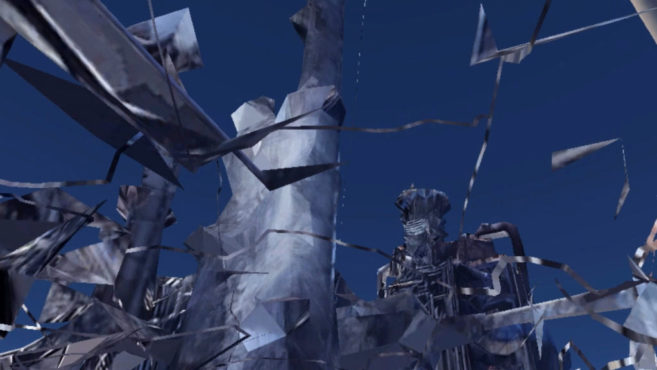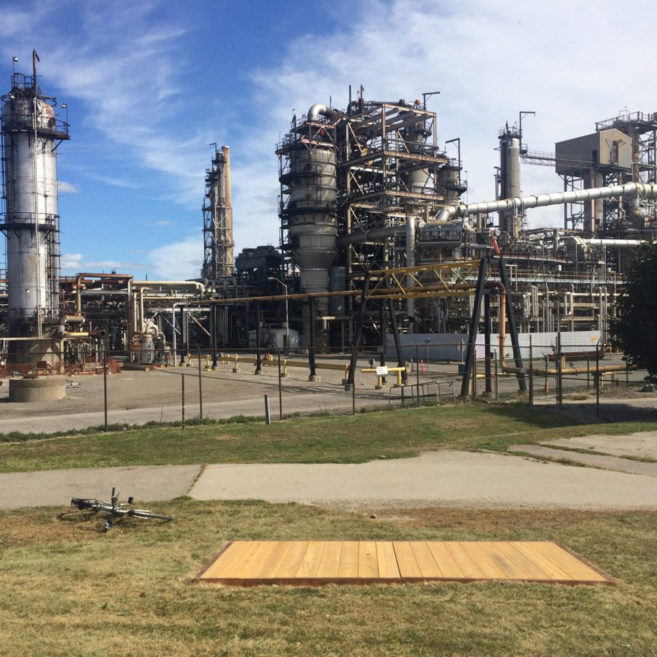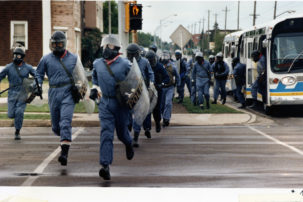I’ve been thinking a lot lately about the current social climate: with the rise in fascism, austerity budgets, conspiracy theories and paranoia, and the eternal threat of climate change, the state of things is increasingly hard to ignore. There are, of course, some who are ignoring it—those in positions of power, most certainly, because for them the state of things is by design. But others ignore it too. If you’re paying attention, it’s difficult to understand why some don’t see what others see coming, or what others already experience. Brett Story’s 2019 documentary The Hottest August helps make sense of this disconnect. As a formal strategy, the film makes visible the shape of our current moment as a nebulous web made of a multitude of threads, woven together across blurry boundaries.
The title itself evokes a preoccupation with climate change—with contemporary conversations of the “hottest months not seen in years” now so familiar in the context of the climate crisis. August 2017, the title’s specific reference, wasn’t the hottest August in New York’s history though, not in terms of temperature at least, and so the title also evokes a consideration of weather in a more expansive sense. It was during that same summer, after all, that the current rise in fascism became visible to many: when a Unite the Right rally in Charlottesville, Virginia, resulted in the televised and repeatedly watched murder of Heather Heyer, a 32-year-old woman protesting against the white nationalist rally. As Christina Sharpe reminds us, phrases like Story’s title, the hottest August, can refer beyond: “It is not the specifics of any one event or set of events that are endlessly repeatable and repeated, but the totality of the environments in which we struggle; the machines in which we live; what I am calling the weather.” By addressing climate change indirectly, the film creates a sense of the ongoing crisis as a haziness—eternally present but not always visible. This is how climate change works: its persistence is fuelled by the intersecting systems and structures that make up all parts of society.
“There is a big question, the urgent, yet deceptively simple question, of how we bear a world that, in its current configuration, is so bad for most of us, and benefits so few of us,” Story explains.
Story invites us to consider the future with the help of many perspectives: an Afronaut, an environmentalist, a recent college graduate and a number of other characters share their hopes and dreams for the future (although “hope” is rarely referred to directly). While revealing their own struggles and bias, each helps make visible the state of the climate in the sense that Sharpe contextualizes. The first subject introduced is a man who, after a life of work, is now living out his dream of moving closer to the beach. He’s proud of that work—especially of having been part of a labour union—and refers to it as one of three key things to live one’s life by: “If you’re not in the military, you’re not in college…you gotta do something—there’s three things.” These three things—military, college, labour—reappear throughout The Hottest August, directly shaping what we come to understand as overall climate.
Another of the film’s primary themes is introduced early on when we meet L’Rae, pronounced by her parents as “Lira,” we’re told, “like ‘money’ in Italian.” L’Rae works at a call centre, where she assists mutual fund owners, while also attending college. Capital is also at the heart of the film, and another character helps make this relationship visible: first by showing us what he sees in two large, abstract paintings hanging in his office boardroom. As he draws attention to forms within the paintings, he points out that once a pattern is revealed, it’s difficult to unsee it. I’m reminded of the concept of pattern discrimination, which, familiar to both computer science and psychology, reveals how patterns operate in both on and offline experiences. I come to view Story’s film, then, as an amorphous volume of noisy data points containing patterns that need to be made sense of: “pattern discrimination—that is, the ability to filter information from data—is an essential part of human, but also nonhuman, cognition,” writes Clemens Apprich in his essay “Data Paranoia: How to Make Sense of Pattern Discrimination.” “However, what is at stake is the question of how and to what extent these patterns are themselves built on racist, sexist, and classist beliefs?” I remember to look out for the patterns.
Throughout the film, a narrator speaks to us from the future about our current moment, while simultaneously reflecting on a past summer (and a storm—Hurricane Sandy—from an even further past): “A plan, a memory of the future, tries on reality to see if it fits.” It’s a quotation, we’re told, from a wilderness survival guide, clearly meant to help us find strategy for making it through our fraught moment. The disconnect this quotation points to, between the way in which we prepare for the future and our reality, is a thread unravelled across the length of the film. Story explains, “The project was always intended to try and circumvent the tragedy of hindsight—in other words, to offer a way [for] us to look at ourselves now in the way we might from a future place.” By playing with the timeline, this space for reflection allows for something beyond the need for hope, something that is more active, more generative—some sort of plan. But what is the plan?
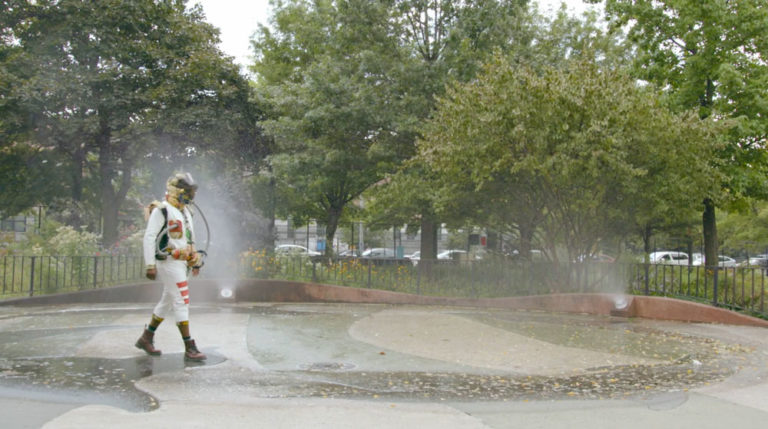 Brett Story, The Hottest August (still), 2019. HD video and sound, 94 min. Canada/USA.
Brett Story, The Hottest August (still), 2019. HD video and sound, 94 min. Canada/USA.
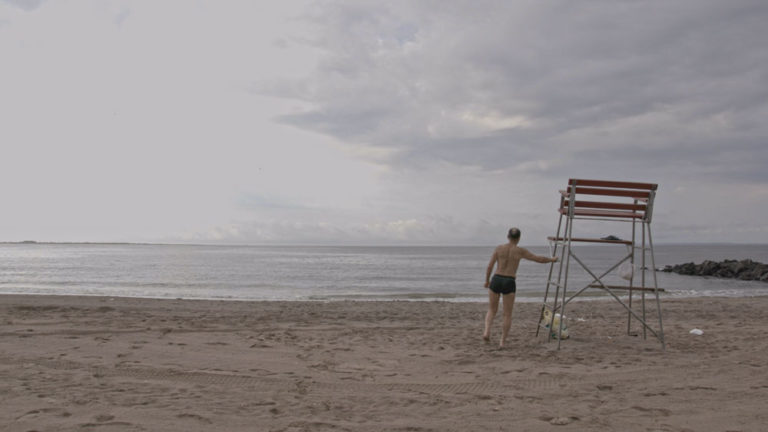 Brett Story, The Hottest August (still), 2019. HD video and sound, 94 min. Canada/USA.
Brett Story, The Hottest August (still), 2019. HD video and sound, 94 min. Canada/USA.
It’s striking how often, when asked how they feel about the future, interviewees in the film respond with plans that include only three options. A young man recounts the mantra introduced at the start of the film, sharing that upon graduating high school his mother told him: “You either go to the military, or you go to college, or you get a job.” Is this the plan then? Repeatedly we’re given insight into how this plan isn’t working for many of Story’s younger interviewees. Their plans seem to come from a different time, no longer relevant to the moment we live in. But what does it mean to stick to a plan that is no longer viable? It’s no coincidence that those who are young, Black, women and people of colour all tell us they have been trying to follow “the plan,” but aren’t quite where they expected to be. On a beach, a young woman explains that she was valedictorian of her college, graduating with a degree in physical and environmental geography. While building a sand castle, she and her friend laugh as she explains how it’s not a good time to get a job in her field right now, “for reasons…for political reasons.” This is a pattern to recognize.
The Hottest August gives us the space to recognize the patterns repeating and reinforced all around us, a space in which we might begin to find a new plan.
The precision of The Hottest August’s editing constructs a shape that glimpses the totality while offering a distance we aren’t usually afforded. I can’t help but think about how the patterns rising to the surface during the film might arise differently for different viewers. Experience matters, and the film is shaped by the experience of difference presented through the interviewees’ perspectives. The film gives us room to listen, to contemplate and try to make sense. Through this pattern of difference, it becomes clear that there is a generational divide in how we see the future. Story gives people room to present themselves as they are, and on their own terms—complete with their own bias and judgment. The persistence of this bias—of this racism—is another pattern to recognize. When asked if they think there is still racism in America (following questions that reveal they hold racist perspectives), two white men sitting at a bar assuredly reply, “Yeah, totally, 100%…it will never go away.” Even Story seems surprised by their comments. Their plan necessitates divisiveness at the expense of others, and it’s a plan they are not interested in adapting.
I’m reminded of our recent federal election—where we were told to ignore evidence that our current prime minister had engaged in blackface and brownface, to ignore that our government is taking Indigenous kids to court—because the alternative was a new government that wouldn’t deal with the climate crisis. As if these things weren’t related. As if they weren’t indicative of a larger pattern. And what happens when some among us don’t see or follow these patterns? What happens if they’re not even trying to come up with a plan? As the Afronaut reminds us, the ability to see a future at all is more difficult for some—especially for those sitting on the margins, those who have been unequally impacted by the original plan of the nation.
Almost halfway through the film we’re introduced to a de-escalation tactics workshop, whose participants have been asked to close their eyes and point toward an exit. Although as viewers we don’t yet know where the exits are, many participants are pointing in different directions, and I wonder if they can all be right. It is within this moment that the otherwise blurry and all-encompassing fog becomes clear to me, for a second. Collectively, we’re unable to agree on our exit strategy, unsure of what the plan is. Is that what we should plan for then? That some of us have made note of the exits upon entering the room, and that some of us can recognize the patterns to help see our way out of it?
I’m struck by the number of perspectives that construct the film, but also by those that are absent—the ones from those responsible for continuing to perpetuate the plan of unchecked capital and exploit, like the richest and most powerful among us who have been preparing plans of their own for when things truly go sour. That missing one per cent—they have a plan—or they at least have the time, space and capital to create one. Or the preppers—often with ties to white nationalists and militias—who have been planning for at least the past decade, imagining a future and how they’ll survive it while building bunkers and stockpiling weapons. How does this pattern fit in with the plans made by the rest of us? In an email exchange, Story eloquently explains, “There is a big question, the urgent, yet deceptively simple question, of how we bear a world that, in its current configuration, is so bad for most of us, and benefits so few of us. How do we live with it? Why don’t we change it?” Here, I find Story’s use of “we” to be critical, for whether we agree, whether we see the same patterns, the film shows us that “we” are nonetheless connected within this hazy cloud.
The Hottest August gives us the space to recognize the patterns repeating and reinforced all around us, a space in which we might begin to find a new plan. Clearly, the plan handed down to us isn’t working for many; it needs to adapt, “So that we might see the fantasies we hang on to as just that—fantasies—and perhaps…let some of them go for the sake of creating something better.”

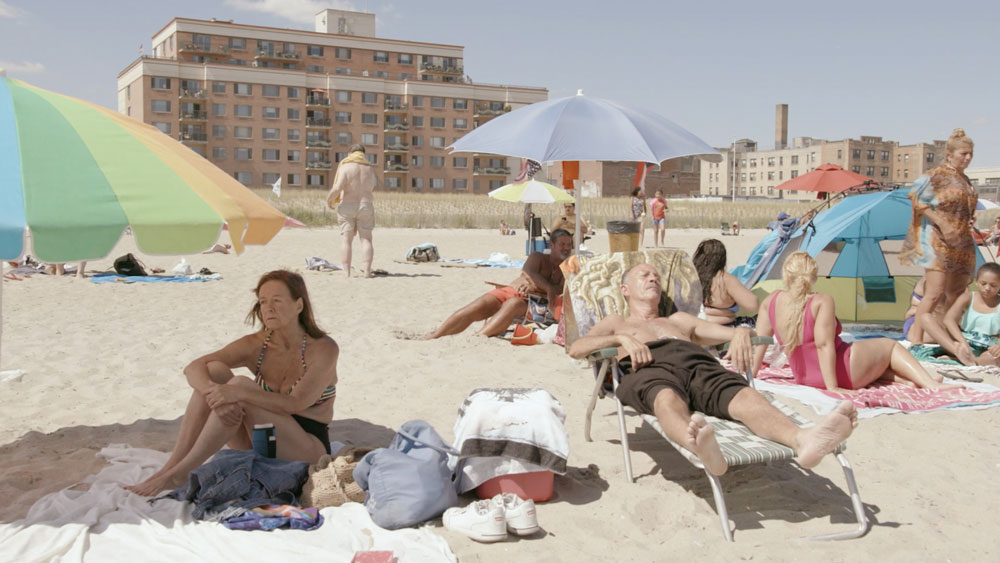 Brett Story, The Hottest August (still), 2019. HD video and sound, 94 min. Canada/USA.
Brett Story, The Hottest August (still), 2019. HD video and sound, 94 min. Canada/USA.
